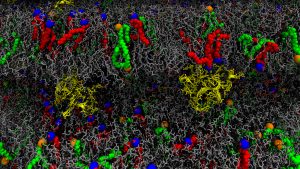Nov. 3, 2022 — Several months into the COVID-19 pandemic, those outside the biomedical community were reminded of a term many likely had not heard since their biology courses in their teenage years: messenger RNA, or mRNA. mRNA is normally involved in transcribing and translating the important genetic information contained in DNA to produce proteins—the key class of molecules underpinning all life on Earth.

For decades, scientists have researched how to use mRNA’s information-sharing capabilities as a way to deliver medication inside the body. During the coronavirus pandemic, researchers from German biotechnology company BioNTech and American pharmaceutical corporation Pfizer became the first to complete successful clinical trials of an mRNA vaccine and to receive a license for medical use.
In traditional vaccines, a dead or weakened version of a virus is injected into a person to elicit an immune response.The immune system “remembers” this respone and can redeploy it when the body is infected by an active virus. In contrast, mRNA vaccines include a slice of a virus’s genetic sequence. When translated, the resulting proteins trigger the immune response, once again training the body to respond to infection. Because mRNA vaccines do not require the generation of virus specimens, they can be produced much more quickly.
This new approach to designing vaccines is not without challenges, however. Using mRNA vaccines against other illnesses will mean delivering them to locations in the body where they are needed. Vaccines like those produced by BioNTech and Pfizer use nanoparticles containing special lipids to deliver their therapeutic payloads into specific cells.
“The specific composition of the lipid-based nanoparticles is crucial to determine how efficiently mRNA is delivered and released into to the target cells to produce proteins, said Dr. Giovanni Settanni, a scientist at Johannes Gutenberg University of Mainz (JGU). “With present formulations, only 2 percent of the injected RNA is really productive. We need to understand more precisely how the nanoparticles work at the molecular level and design more efficient lipid formulations.” In an effort to help identify the best lipid-based particles for drug delivery, Settanni and his collaborators at JGU and BioNTech are using high-performance computing (HPC) resources at the High-Performance Computing Center Stuttgart (HLRS) to run large-scale molecular dynamics (MD) simulations.
Better Success Rates Lead to Better Therapeutics
In order to use mRNA to produce viral proteins, biomedical researchers must ensure that the molecules do not degrade prematurely and that they safely cross a cellular membrane without being attacked by antibodies before reaching their destinations. Before the pandemic, research showed great promise in using lipid-based nanoparticles (LNPs), lipoplexes and liposomes, to deliver mRNA-based therapies.
Settanni’s collaborators have used experimental techniques to shed light on the internal structure of LNPs, including how the lipid formulations interact with the RNA molecules and how this affects the transfection efficiency, the amount of RNA that is successfully translated into proteins. Experimental approaches alone, however, cannot provide details of these interactions at the molecular level. Using HPC, Settanni and his collaborators are able to accurately model the lipid-RNA interactions taking place in the nanoparticles, allowing the researchers to observe processes occurring at the molecular level.
“The large-scale molecular dynamics simulations that we can afford on the HPC resources provided by HLRS are like an extremely powerful microscope that can shed light on the molecular aspects of a system,” Settanni said. “They provide fundamental information that helps to interpret the experimental data on the LNPs at the molecular level. The results obtained from the simulations can be used to help design improved nanoparticles.”
With the help of HLRS’s Hawk supercomputer, Settanni and his collaborators noticed that pH—the relative acidity or basicity of a liquid—plays a significant role in this process. The researchers found that RNA binding to the lipid formulation happened more efficiently at low pH, while the two sets of molecules were more likely to be repel each other in high-pH systems. This helps researchers understand how the nanoparticle structure changes when it is taken up by the cells where the pH changes from basic to acidic.
“The results obtained with the simulations show how we could use this tool to speed up the process of identifying promising lipid formulations for improved transfection efficiency. They also suggest how some of the molecular events, leading to RNA delivery, may take place,” he said.
HPC Accelerates Fast-moving Medical Research
The coronavirus pandemic both laid bare humanity’s close but fraught relationship with microbes and revealed the need to improve information sharing and funding mechanisms to defend against emerging illnesses. Although remarkably effective and developed at record speed, present-day mRNA-vaccines offer space for improvement both in terms of stability (such as room-temperature storage), efficiency (low dosage, with consequently lower side effects), as well as, specificity (targeting different tissues). The combination of experimental and computational approaches may help reaching these goals.
More powerful computers allow researchers to run larger and longer MD simulations, and new computer architectures open up new ways to approach long-running scientific challenges.
Source: Eric Gedenk, High-Performance Computing Center Stuttgart



























































